In this article (clickable table of contents):
- I. The outdated RDA on protein
- II. New research shows how women respond to higher protein diets
- III. Why we need to think about protein on our plate first
- IV. Muscle protein synthesis and muscle protein breakdown
- V. How much protein you need: reproductive years, perimenopause, menopause
- VI. Fueling around your workouts
- VII. Ideas for getting more protein in your meals
- VIII. Wrap up and recommendations for further reading
The outdated RDA on protein
To continue our conversation about outdated research that was not done specifically on women(1), I wanted to discuss a topic that comes up frequently in our coaching calls in Rock Your Life and online discussions everywhere which is how much protein for women to eat and why.
Old research that was done on sedentary male test subjects and informed the “RDA” indicated that we only need 0.8 grams of protein per kg of body weight. That translates to about 55 grams of protein if you weigh 150 lbs for example.
While this may cover baseline survival needs at a low activity level, this is too low for active women, anyone at risk of losing muscle mass (women going through perimenopause or menopause for instance), and anyone looking to shift their body composition to lower fat and more muscle (2). For a refresher on how muscle works and why I suggest you focus on preserving (and gaining) it as you age, read this.
New research shows how women respond to higher protein diets
There have been numerous articles published since then that show the limitations of that old recommendation. Here’s an excerpt from a 2016 scientific article (3) that sums it up nicely:
Higher protein intakes may help prevent age-related sarcopenia, the loss of muscle mass, and strength that predisposes older adults to frailty, disability, and loss of autonomy.
Higher protein diets also improve satiety and lead to greater reductions in body weight and fat mass compared with standard protein diets, and may therefore serve as a successful strategy to help prevent and/or treat obesity.
Athletes can also benefit from higher protein intakes to maximize athletic performance given the critical role protein plays in stimulating muscle protein remodelling after exercise. Protein quality, per meal dose, and timing of ingestion are also important considerations.
Despite persistent beliefs to the contrary, we can find no evidence-based link between higher protein diets and renal disease or adverse bone health.”
Another study (4) from 2019 compared 2 groups of women: one group who ate the old “standard recommended amount” which adds up to roughly 15% of your daily intake (in the study this is the “SP” or “standard protein” group) and another group who ate a higher amount of protein – roughly 25% of their daily intake (represented in the study as the “HP” or “high protein” group).
At the end of the 12-week study, the results clearly showed that fat mass (FM) was lower in the higher protein group, and lean mass was higher (muscle tissue) in the higher protein group. In yet another study from 2019 (5), the results clearly showed that a higher protein intake (than the old RDA) combined with physical activity led to better cardiovascular health and a healthier body composition.
If you need any further indication that paying attention to getting more than the “average recommended amount” of protein is helpful for your goals, this is it!
In the 2016 excerpt, one of the things pointed out was that “higher protein diets improve satiety.” Protein is the most satiating nutrient – even more so than carbs or fat. So if we shifted our focus to getting an adequate amount of protein with each meal (rather than how many calories we were eating for instance), we’d be more full and satisfied and wouldn’t easily be able to overeat the carbs and fat portion of our meals.
Increasing the protein in our daily intake more intentionally beyond the old standard recommendation brings our meals into a better balance for active women, and supports our body composition goals. Note the comment at the end of the 2015 excerpt which states “Despite persistent beliefs to the contrary, we can find no evidence-based link between higher protein diets and renal disease or adverse bone health.”
Why we need to think about protein on our plate first
According to the CDC, falls are the leading cause of injury-related death in adults over 65 (6). This is in large part due to how brittle our bones become as we age. As women, losing the cycling of estrogen and progesterone post menopause packs a double edged hit as we lose the stimulus to both modulate bone loss and there is an increase in bone turnover.
So as we age as women, we need to be thinking about alternative routes to stimulate the bone remodeling (think resistance training), keep the protective muscle tissue healthy (think upping your protein intake) and being consistent with these strategies over time.
Too often we focus more on low carb, low fat, sugar free, fasting, calorie counting, keto, or some other weight loss-focused dietary strategy. All of these dietary strategies can have their merits for different people at different times, but in my opinion weight loss alone is the wrong focus for long-term health.
When we replace “weight loss” with “healthier body composition” we shift our focus to prioritizing muscular strength for longevity (with its added benefit of promoting more fat loss). This helps us approach our goals differently. We’re thinking more about “how can I eat to support my muscle tissue around my workouts” as opposed to “how do I eat within the calorie/time restrictions my diet says I need to stay within” for instance.
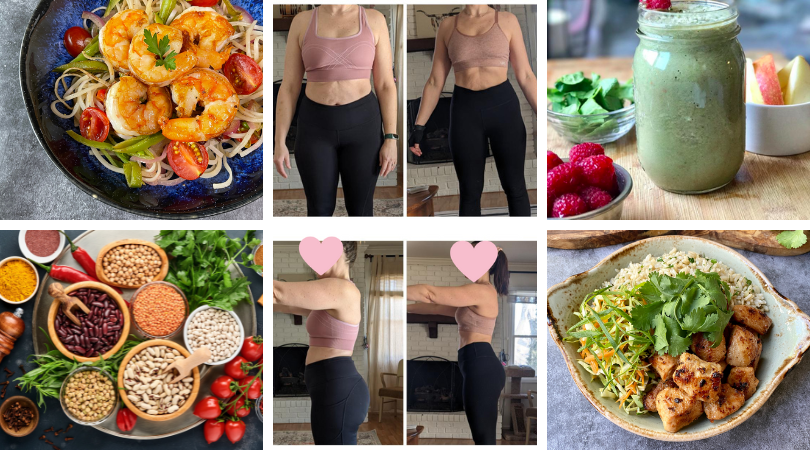
Without the right building blocks your body simply can’t build muscle, and those building blocks include the amino acids we get from dietary protein. However, many women are all over the place with the amount of protein they’re eating – not really thinking about it as a factor in supporting our goals.
While we may think we’re “eating protein,” most of us are not including it as consistently as we need to be, or in the amounts we need to support ourselves. As a result, we’re always having cravings, we’re not seeing much change in our body composition, we’re definitely not building muscle despite all those workouts, and we’re often overthinking how complicated it needs to be to feed ourselves.
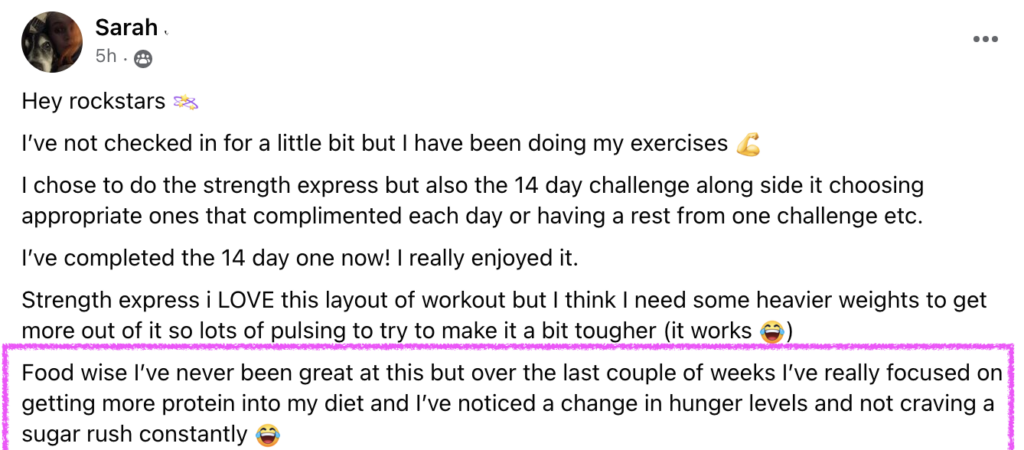
Muscle protein synthesis and muscle protein breakdown
Let’s talk about what we’re getting from the protein in our meals. The protein that we eat breaks down into amino acids. The amino acids are used for numerous processes, including hormone and enzyme function, brain function, our immune system health, and of course muscle protein synthesis, or growing those muscles.
The type of protein source will determine what amino acids are present in the food you’re eating. Most animal derived protein contains all the essential amino acids (the ones your body can’t make on its own and must get from food), while most plant protein contains many of the essential aminos, but not all – meaning you would need to eat a variety of them to cover all bases.
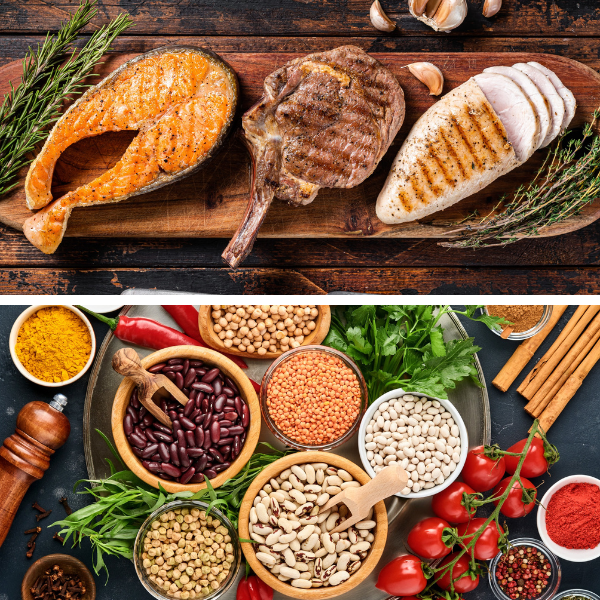
Within the essential aminos are the branch-chain amino acids, or BCAA’s. These are optimal for supporting your muscle tissue repair and recovery and for stimulating muscle protein synthesis, which is how we build muscle. Leucine is the most important of these (7) for stimulating muscle protein synthesis.
So focus on complete protein as often as you can, and don’t hesitate to lean on high quality supplements to cover your bases (more details on that below). If you’re eating less animal source protein, look into what amino acids are in the plant based foods you’re consuming to ensure you’re getting your needs met.
Unlike fat and carbohydrates which are stored in fat cells and the liver (to be called upon when we’re not eating for energy), the amino acids get stored in the muscle tissue. That means that when your body needs some amino acids to support your brain, or needs amino acids for enzyme or hormone function, it’s going to go to your muscle tissue, break it down (catabolize it) and that’s how it’s going to get those aminos it needs to do its jobs.
Eating protein containing foods in all of your meals throughout the day is ideal for supporting the natural turnover of muscle protein breakdown and muscle protein synthesis (8). We want to continuously contribute to the amino acid “pool” our body is constantly drawing from for all it needs to function.
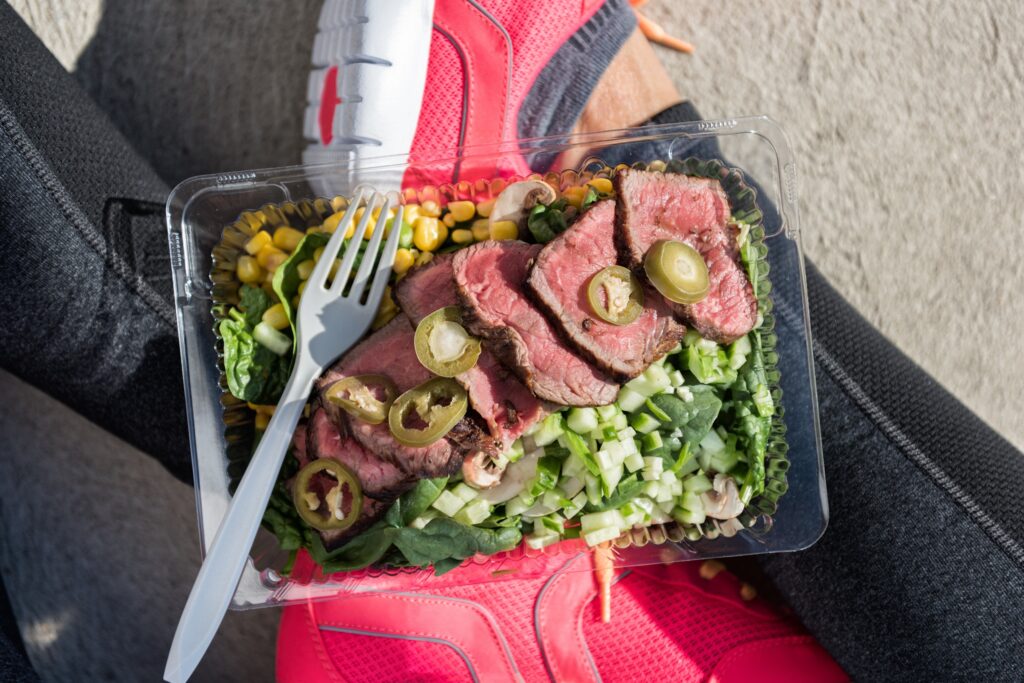
Muscle protein breakdown and muscle protein synthesis are normal processes that occur all day long. But if you’re always in a depleted state when it comes to your amino acids, you’ll always be in a deficit and breaking down more than you’re building.
What far too many women end up with is a deficit of available amino acids from their daily dietary intake because they’re not prioritizing protein, so the body just keeps breaking down muscle to get the aminos it needs for all its other tasks. It doesn’t matter how many workouts you do, you simply can’t build muscle without the nutrient building blocks.
Because they’re then not seeing the results from their training/workouts that they thought they would, many women start food restricting, causing cortisol to rise (promoting stress and body fat storage) plus more muscle breakdown. I also see a lot of overtraining and stress about their workout not being “enough,” so they ask even more from their bodies by working out even more.
But a workout in itself creates muscle breakdown, as we’re putting the body under stress and load. If on top of that we don’t have the right building blocks for growth and repair, we’re setting ourselves up for injury, lowering our immune response and definitely not seeing better results.

It’s in the post workout period where we’re recovering (and fueling) that we build ourselves back up stronger. If we’re not eating, or not eating the right nutrients, the body cannot rebuild and instead will go on breaking down our muscle tissue. If we’re overtraining and under-fueling, we’re constantly in a deficit and not able to build muscle or burn fat. This is also a dangerous long-term strategy that ultimately backfires, leaving many women burned out.
Whether your workouts and activity level deliver the results you are looking for depends on what kind of fuel you’re giving your body (not to mention how you’re resting and recovering, and how you’re managing your stress). You simply cannot build muscle without adequate consumption of protein in balance with your other nutrients.
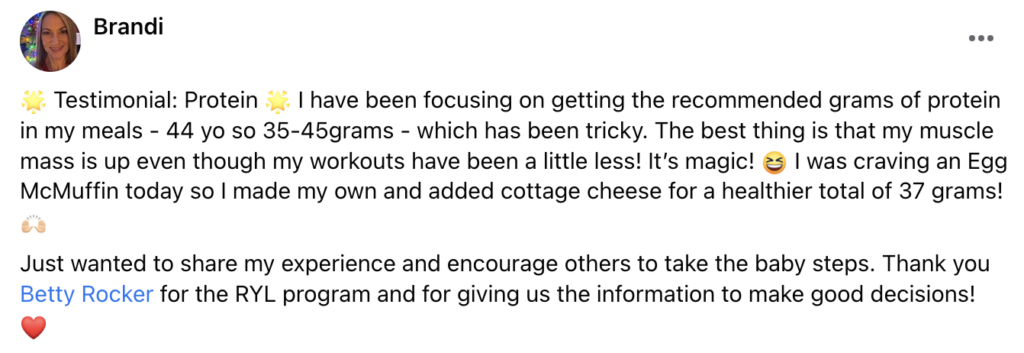
I know it can feel a bit overwhelming to try to determine exactly how many grams of protein, carbohydrates and fat you need each day. And the truth is, it really varies and there isn’t a perfect number for you that will be true every single day. But there ARE some important ranges of protein that you can start with that will really set you up for success depending on your age/life stage and that’s what I want you to focus on in the coming weeks as an experiment to see how you feel.
Remember as you read these numbers that they are starting points and suggestions. You don’t have to hit them every single day exactly, and there will be some people who do better on a higher or lower range. But they are a great place to start thinking about what you’re putting on your plate.
One of the easiest ways to look at this for yourself is to consider the stage of life you’re in as an active woman.
How much protein you need: reproductive years, perimenopause, menopause
If you’re an active woman who is still in your reproductive years, for starters, aim for 20-30 grams of protein in each meal with the goal to get closer to 100 grams of protein daily. If you’re highly active, you may increase that.
Rather than constantly focusing on a calorie goal or tracking each of the foods you eat with a macro calculator, consider simplifying and just building each meal around a protein source that can give you that range of grams of protein.
The protein you eat will make you feel more full and satisfied, and if you eat the right amount of it it will be very hard to overeat other nutrients. You won’t feel the same cravings or want to snack as often because you’ll actually have the nutrients your body was looking for all along.
Don’t skimp on your carbs or fat – just build a balanced plate and start being mindful that protein may need a bigger role than you previously gave it.
As we shift into our 40’s, it’s essential to make protein a priority as we begin to lose our ability to absorb it as readily into the muscle tissue. Increasing your intake beyond what you were in your 20’s and 30’s can help reduce muscle wasting and support you in strengthening your bones and muscle tissue when you combine it with your training.
I can’t stress enough that no matter how much you workout, you will not see results (less body fat, more lean muscle) without proper nutrient intake.
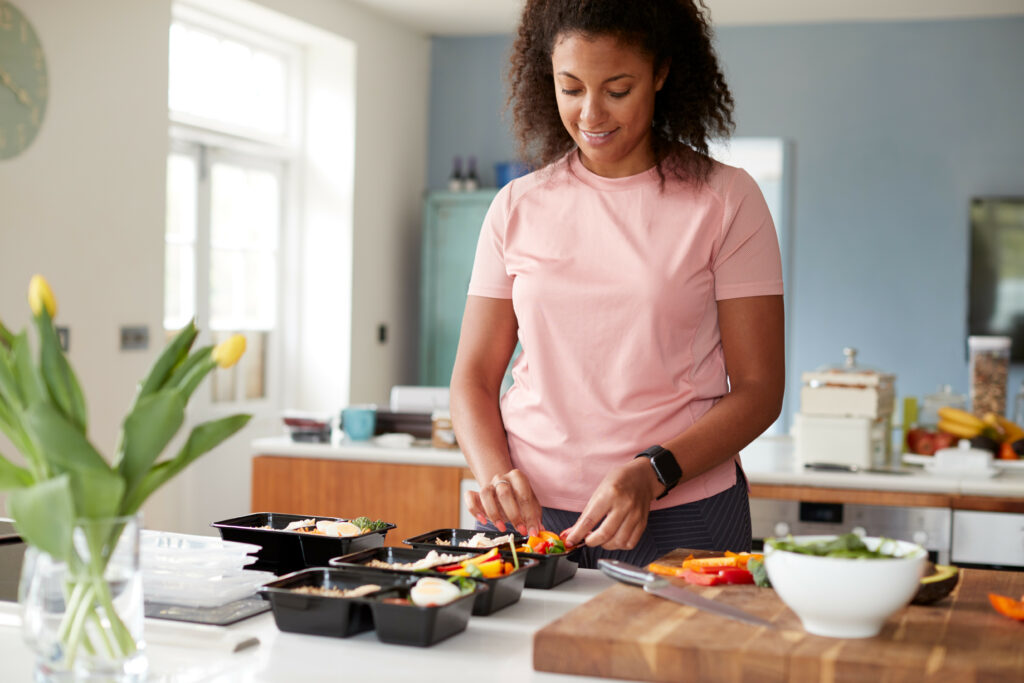
If you’re in that transition stage between your reproductive years and menopause called perimenopause, you’re beginning to lose the constant back and forth of the estrogen/progesterone loop which has an impact on your ability to build muscle and also impacts your insulin sensitivity and fat storage.
Not to mention that as we age, we begin to lose the ability to absorb the amino acids from protein as readily. For all of these reasons, it is ideal for you to start to work on getting closer to 30-40 grams of protein per meal in.
Getting enough of those amino acids in daily from your dietary protein can help reduce some of the central nervous system fatigue and brain fog we start to feel as estrogen and progesterone levels become erratic and begin to drop off.
I can’t stress enough that this is not the time to start doing more workouts or skipping meals.
The changes you’re seeing are coming from the slowdown of estrogen and progesterone and to circumnavigate this hormone shift one of the things we can do is get the amino acids in that our body needs (for more on what you can do, see my previous article, section VI on this topic).
As you hit menopause the estrogen and progesterone levels flatline, and we lose the cycling estrogen and progesterone which in the past drove muscular adaptations. We don’t absorb the amino acids from the protein we eat as easily at this point in our lives either, and metabolism begins to slow.
We can bypass some of these hurdles by increasing our protein intake if we haven’t already started in perimenopause. The recommendation is 30-40 grams per meal here as well. Not only will this stimulate the tissue better, but there’s a thermic effect that occurs when we eat – especially when we eat protein – which will stimulate the metabolism.
This will provide you with the building blocks you need to help you reap the rewards from your training, even without the old perturbation of estrogen and progesterone. If you’re resistance training (using the strategies I outlined in this article, section VI), eating enough protein for your needs in balance with your other whole food sources of fiber-rich carbs from fruits and veggies, whole grains and quality fats you’re going to see your body respond well.
Fueling around your workouts
One final note I want to touch on is the importance of fueling around your workouts. Due to the popularity of “weight loss” diets, a lot of us tend to focus more on what the scale says rather than our muscle to fat ratio (body composition) which is a much better indicator of our health, strength and how we look than how much we weigh.
I covered body composition in depth in this article, but in a nutshell I encourage you to shift your focus towards how you can support lean muscle production rather than on how much you weigh, or on fat loss alone. As you strengthen your valuable muscle tissue, you will look more compact (not bulkier) and you will be a more efficient fat burner in general. Eating and training to support your muscle also supports your bone health and bone density plus surrounds and supports your joints which provides you with better balance, agility and stability as you age.
Remember, when you workout, you are breaking down your muscle tissue. We are creating micro-tears in that tissue, putting stress on our system (in a healthy way – when we are healthy). This is one of the reasons overtraining doesn’t work long-term – and why it doesn’t work in the later life stages of a woman’s life when we’re simply not absorbing the amino acids we eat as easily. We have to train smarter, not harder and think outside of our training for the pieces that build a strong, healthy body.
Bottom line is that it’s ideal if there’s an amino acid pool to draw from during your workout and that you’re not already in muscle protein breakdown going into the workout since you’re going to be breaking down muscle while you exercise. I suggest doing your workout an hour or so after a regular meal, or if timing doesn’t work well having a serving of protein with a little fruit shortly before your workout (depending on your tolerance).
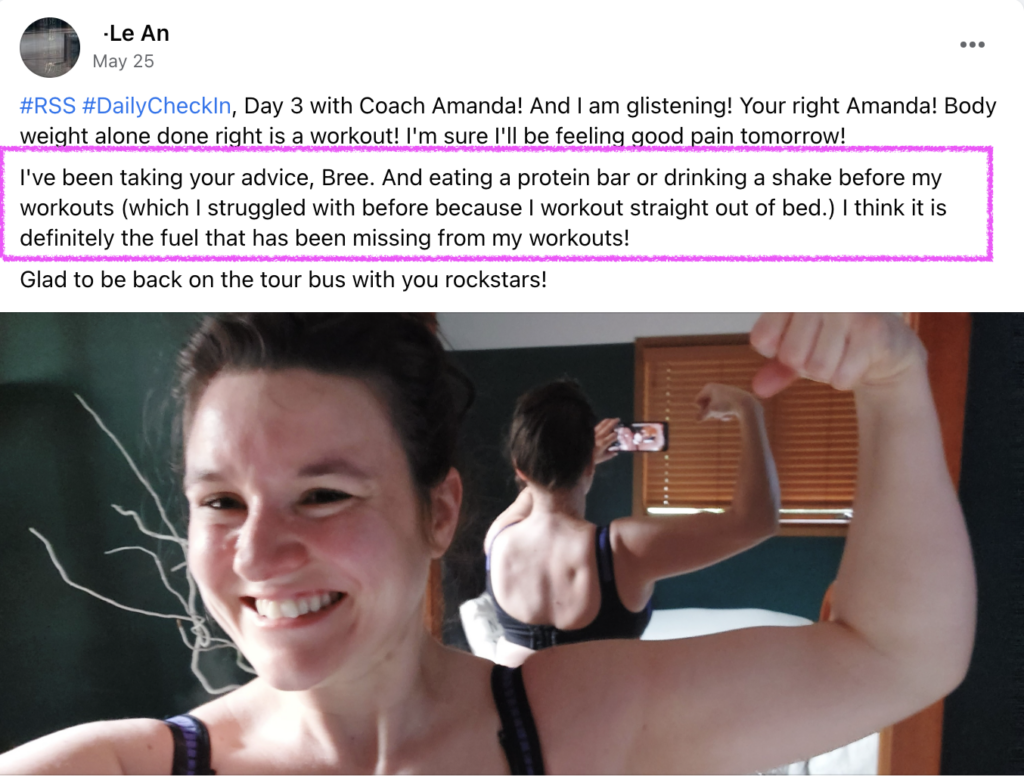
Skipping a meal before a tough workout means you go into it without any amino acid reserves and your body is depleted and in a deficit. You won’t have as much energy and it may also mean that your cortisol levels are elevated, which promotes more fat storage. Remember that women have more kisspeptin receptors than men do, making us more sensitive to our hunger/fullness cues. If you’re using intermittent fasting in your life for whatever reason, ideally don’t do it around your workouts.
After my workout, if I had a shake before the workout I’ll be sure to eat a meal that contains an optimal amount of protein for my needs to replenish my amino acid reserves and support the repair and recovery of the muscle tissue. If I had a meal an hour or so before my workout and it’s not really time for the next full meal yet, that’s when I’ll have a smoothie or a shake to get me through til my next meal.
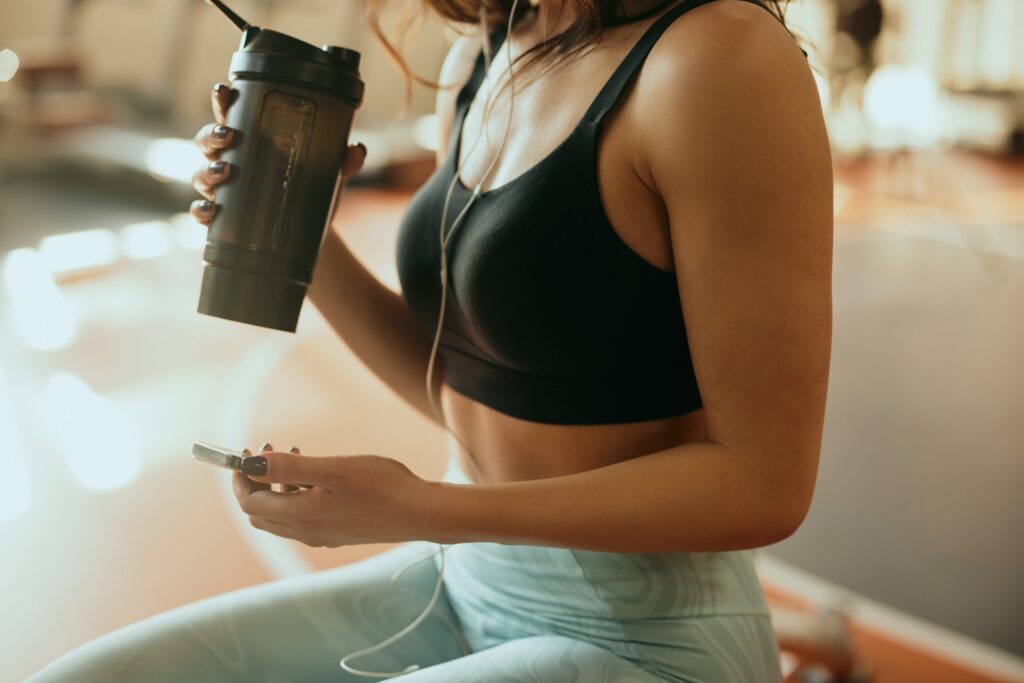
Ideas for getting more protein in your meals
These are just some suggestions from me, you can also lean on the recipes on this blog or use my meal plans. The recipes are a great place to start, however you may still want to adjust the amount of protein my (or any recipes) contain to meet your own needs depending on your life stage.
Breakfast:
If you’re having eggs, consider adding egg whites from an egg white carton to your whole eggs. 2 eggs is a good amount of healthy fat and the yolk contains vital nutrients that help you absorb the egg protein even better. But you can stretch out the protein amount without going overboard on the fat content by adding egg whites.
This may make you feel more full and satisfied, so instead of having 2 pieces of toast on the side, you’ll only need one. You could also stretch out the protein in your egg breakfast with a breakfast meat on the side.
If you’re in the mood for a sweeter breakfast, consider making my easy protein pancakes. By adding a serving of protein powder to your 2 egg + 1 banana recipe, you can get closer to 32 grams of protein in your pancakes without even noticing. You could use a little Greek yogurt on top as a garnish if that sounds appealing.
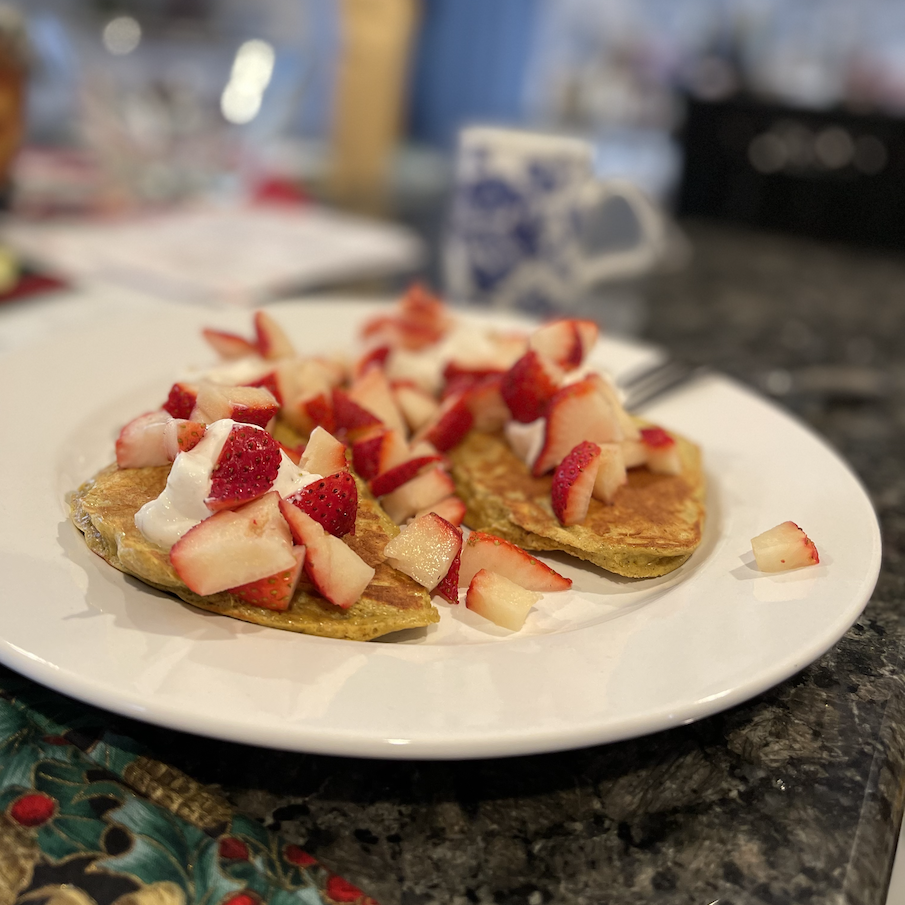
If you’re in the mood for oatmeal, consider my Unicorn Bowl upgraded recipe and blend your oatmeal up with a little milk of choice, protein powder and even a little fruit. Tasty and the satisfaction and fullness from this breakfast will last much longer than the oatmeal alone.
If you’re looking up recipes online or in a cookbook, you can see what the protein source is in any meal, look up the grams of protein in that food source, then adjust the recipe accordingly to increase the protein to your needs. Just be mindful of the other nutrients different protein source foods come with, as you don’t want to exponentially increase fat or carbs at the same time.
Lunch:
At lunch, a lot of us are either eating leftovers, having a sandwich or some other type of entree food. In all cases, start with the protein and if you don’t know how many grams it has look it up.
If I’m making a sandwich, I’ll check the amount of grams of protein on the lunch meat I’m using. Say for instance the package says it has 3 servings and each serving contains 12 grams of protein. It’s likely I’ll eat all 3 servings of that package in order to get closer to 36 grams as my life stage lends itself well to a higher amount.

If I’m ordering a sandwich somewhere, I’ll ask if I can have “double meat” or double whatever the protein source is depending on what type of meal it is and how many oz approximately of the protein they’re serving. It helps to have been looking up protein sources and grams of protein in foods regularly to help you more easily navigate this.
Smoothies:
If I’m making a smoothie, I’ll pay attention to how many grams of protein I’m adding. Just because a protein powder is “20 grams per scoop” or 20 grams per serving” that doesn’t mean you just have to use 1 serving/scoop. You can add 1.5 or 2x the serving to get your needs met if that’s the only protein source in your smoothie.
This is a great way to increase your daily protein intake and get those numbers up in addition to your main meals, and give your body another protein intake opportunity. Jenelle and I had a conversation in Rock Your Life (which was a follow up of other conversations) about whether or not it’s ok to use protein powder more than once a day, have a read:
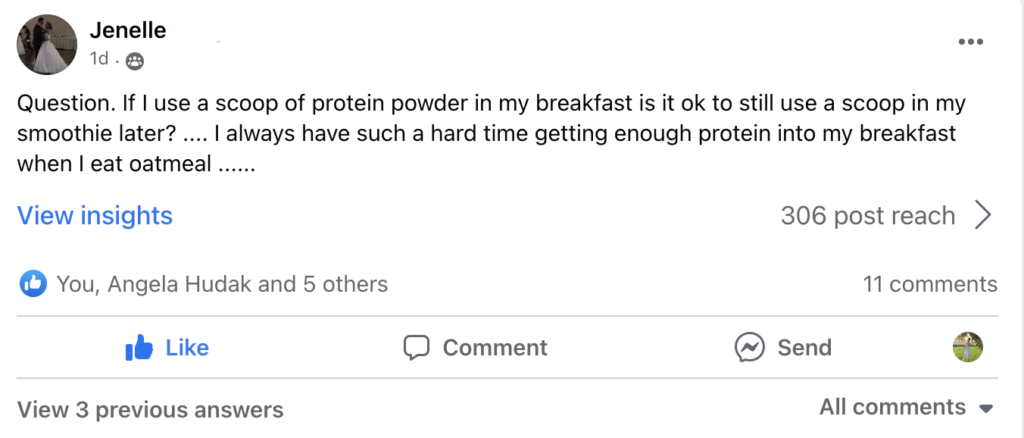
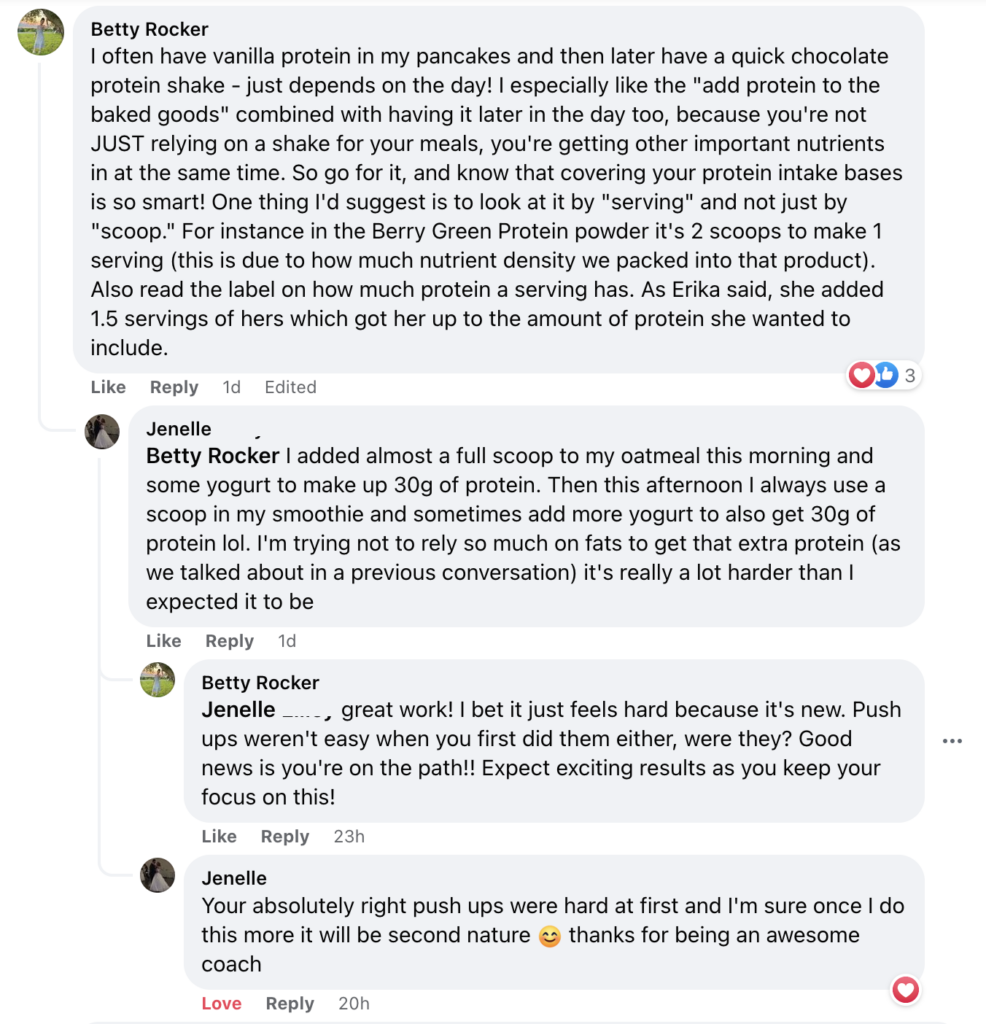
Sometimes I’ll hear from people who are relying on a combination of seeds or nuts alone for protein source in a smoothie. While the protein in these plants is great, the amount of them you’d have to add to get near 20-30 grams of protein would leave you with a much higher amount of fat.
Not that we don’t want our healthy fats, but when the ratio of fat far outweighs the protein you’re having, it’s less than ideal for supporting your goals. This is true of your carb heavy plant foods as well that contain some protein. So consider adding an organic protein powder like mine to boost your protein intake.
What sometimes confuses people is that not all foods are “just protein” or “just carbs” or “just fats.” Quite a few foods are primarily one main nutrient, but others contain a couple. So if you’re looking at nutrition facts for eggs, and you see “6 grams of protein, 5 grams of fat.”
Protein (and carbs) are each 4 calories per gram. So if you multiply 6 (grams) x 4 (calories/gram), you get 24 calories from the protein in the egg. Fat on the other hand contains 9 calories per gram. So you’d multiply 5 x 9 to get 45 calories. As you can easily see, there is more caloric density in the fat portion relative to the protein. This becomes a bigger spectrum when you’re looking at some plant foods that are commonly referred to as “proteins,” but are much more nutrient dense in fat – like seeds or nuts.
I’m not telling you this so you’ll “worry about calories,” only so you’ll understand how to prioritize protein and see the food choices you’re making more accurately.
Dinner:
At dinner, most people gravitate toward a protein source naturally. Be sure it has the amount of protein to serve your needs, and adjust accordingly if it doesn’t. Many recipes have protein in them, but you may need to adjust them a bit to get enough for yourself. Just like I discuss when I talk about adjusting your workout schedule to line up with YOUR cycle, adjusting your meals to line up with what YOU need for your goals is something to get comfortable doing.
Eating adequate protein with dinner (and every) meal will help you feel more full and satisfied, keep you from overeating bread, snacks and dessert and support your body with the amino acids it needs to support your muscle protein synthesis AND all those other essential functions I mentioned like brain function, hormone and enzyme function and your immune system.
Sometimes, dinner is the hardest meal of the day. If you work all day and then have to plan, prepare and clean up from dinner it can just feel overwhelming and as a result a lot of people resort to ordering takeout or just having whatever is easiest.
My best tip for you is to do some pre-cooking for the week whenever you can. It could be just baking a sheet tray of some of your staple proteins or carbs or even making a couple of your meals with enough portions to just heat up and eat after work. Deneatra checked in to Rock Your Life with this inspiring post sharing that she did a little food prep for the week ahead:
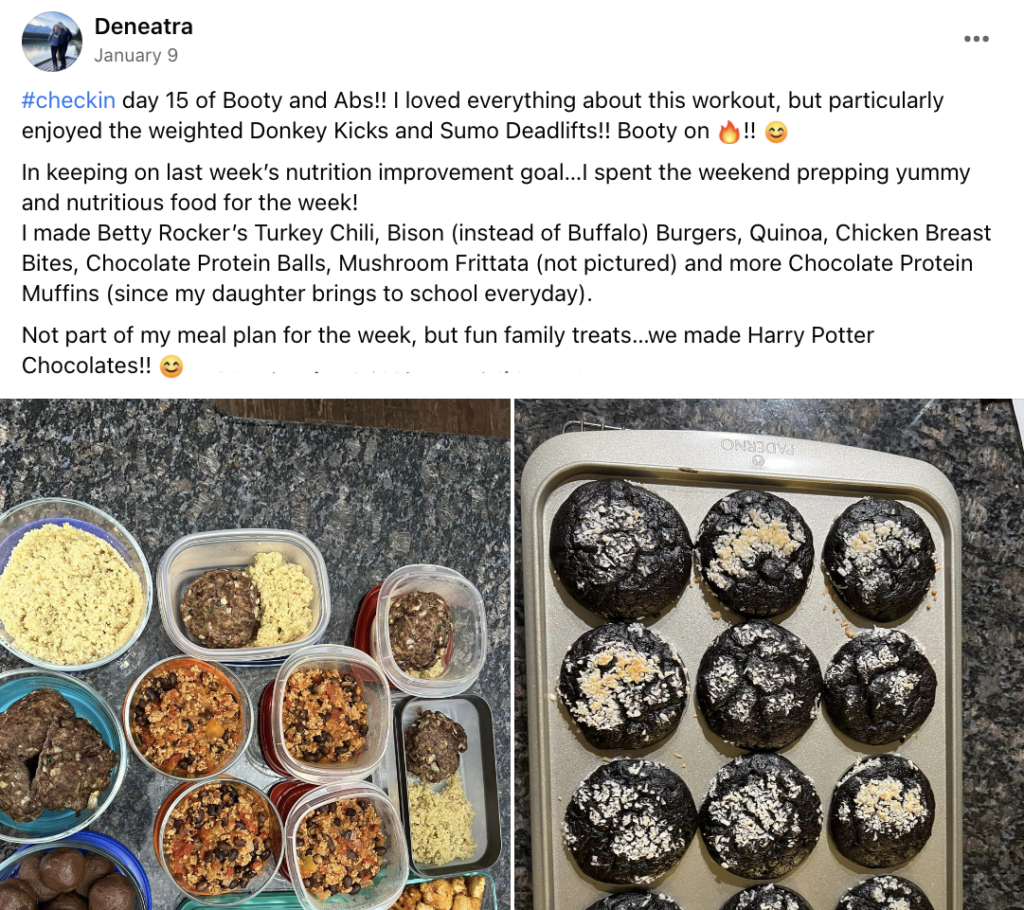
When it comes to dessert, notice how much you want dessert or not when you’ve had enough protein with each meal all day long. There’s nothing wrong with a little sugar, but as we age we become more insulin sensitive and it’s easier to store fat intramuscularly (and everywhere else). So be sure you’re really honing in on getting that quality protein in balance in your meal alongside your other whole foods and you’ll reap the rewards!
Supplements:
In the smoothie section, I mentioned using a protein powder. This is a great idea if you’re active and wanting to make sure you cover your bases, as in reality it’s challenging to get our needs met consistently without a little support!
There are lots of great studies on the efficacy of whey protein in stimulating muscle protein synthesis. Plant based protein powders will also do the trick! A non-dairy option like my organic protein powders (which blend 4 plant protein sources to give you the complete amino acids spectrum) is a great choice. Go for organic when you can, and read the labels to check how many other ingredients are included (how much added sugar is always a good thing to check) and how many grams of protein are in there.
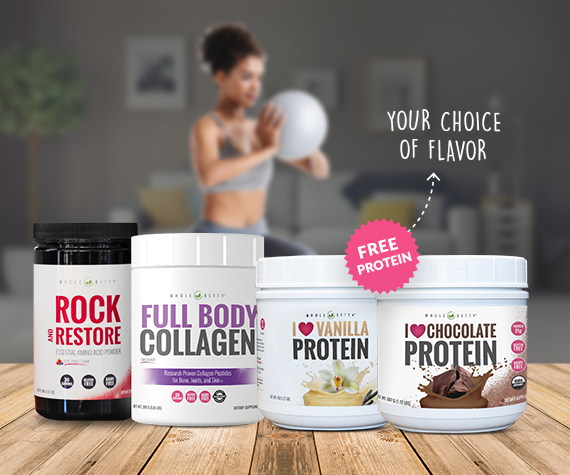
Remember that collagen is not a complete protein, and while it contains amino acids, they are specific amino acids that are not “essential” – however they do a great job of supporting bone, skin and joint health. If you’re using collagen, consider using it in tandem with your other protein sources and protein powders that are from more complete protein sources. I use (my) collagen every day and appreciate all the benefits it provides. I can tell its supporting my system as my hair and nails are so much stronger when I’m taking it regularly than when I’m not. I just don’t suggest counting your grams of collagen peptides toward your daily protein intake.
If you’re using a sports drink while you’re training, make sure it has an optimal amount of leucine. In my Rock and Restore essential amino acid formula for instance, not only do you get all the essential amino acids, there is an optimal dose of leucine (2.5 grams) included. As long as we’re hitting that optimal dose of leucine, we’re going to get the benefit of stimulating muscle protein synthesis AND supporting all the other functions our amino acids serve.
Wrap up and recommendations for further reading
My goal in writing this was to create a reference for you that updates outdated ideas about low protein intake that may not be helping you meet your goals as an active woman. I encourage you to consider prioritizing the protein in your meal first over the coming weeks, then adding the rest of the important nutrients to your plate so you have balance and are giving your body what it needs to support your muscle tissue and all the associated benefits to your health that come along with that.
Join us in Rock Your Life where you can post your daily meals and get support and feedback about how you’re eating without the pressure to “get it perfect” or count calories. Our “all or something” mentality and open judgement-free discussions are as big a part of our members’ success stories as their workouts.
Remember, workouts alone are NOT the fast track to a strong, healthy body that stands the test of time. It’s consistent workouts that are paced right for YOU, and the surrounding activities that create an optimal state in your body for fat loss and muscle growth or whatever goals you currently have. These surrounding activities include your sleep habits, stress management habits, and of course your daily nutrient intake.
References:
-
-
- Brookshire, Bethany. “Women in sports are often underrepresented in science.” ScienceNews. May 2016. Web. https://www.sciencenews.org/blog/scicurious/women-sports-are-often-underrepresented-science
- Carbone, John W. and Stefan M. Pasiakos. “Dietary Protein and Muscle Mass: Translating Science to Application and Health Benefit.” Nutrients. May 2019. Web. https://www.ncbi.nlm.nih.gov/pmc/articles/PMC6566799/
- Phillips, Stuart M. et al. “Protein “requirements” beyond the RDA: implications for optimizing health.” Applied Physiology, Nutrition and Metabolism. May 2016. Web. https://pubmed.ncbi.nlm.nih.gov/26960445/
- Haghighat, Neda et al. “The effect of 12 weeks of euenergetic high-protein diet in regulating appetite and body composition of women with normal-weight obesity: a randomised controlled trial.” British Journal of Nutrition. August 2012. Web. https://www.cambridge.org/core/journals/british-journal-of-nutrition/article/effect-of-12-weeks-of-euenergetic-highprotein-diet-in-regulating-appetite-and-body-composition-of-women-with-normalweight-obesity-a-randomised-controlled-trial/8FB0C6CF8F3D246197100EAD55D17754
- Brown, Ann F. et al. “Higher-protein intake and physical activity are associated with healthier body composition and cardiometabolic health in Hispanic adults.” Clinical Nutrition ESPEN. January 2019. Web. https://www.ncbi.nlm.nih.gov/pmc/articles/PMC6482843/
- “Deaths from Older Adult Falls.” Centers for Disease Control and Prevention. July 2020. Web. https://www.cdc.gov/falls/data/fall-deaths.html
- Dodd, Kayleigh M. and Andrew R. Tee. “Leucine and mTORC1: a complex relationship.” American Journal of Physiology. June 2012. Web. https://journals.physiology.org/doi/full/10.1152/ajpendo.00525.2011
- Phillips, Stuart M. “A Brief Review of Critical Processes in Exercise-Induced Muscular Hypertrophy.” Sports Medicine. May 2014. Web. https://www.ncbi.nlm.nih.gov/pmc/articles/PMC4008813/
-
The post How Eating the Right Amount of Protein Affects a Woman’s Body appeared first on The Betty Rocker.
